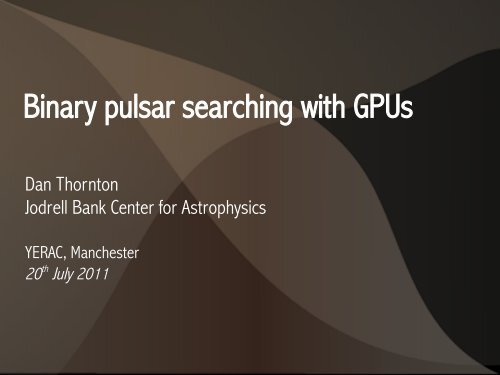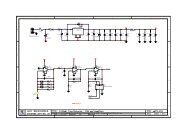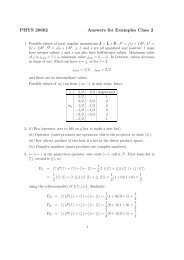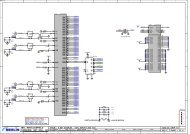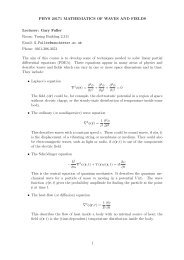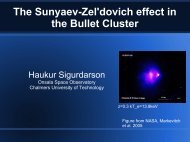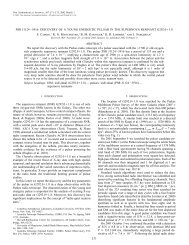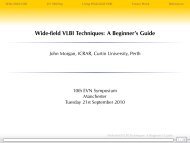Dan Thornton - Jodrell Bank Centre for Astrophysics
Dan Thornton - Jodrell Bank Centre for Astrophysics
Dan Thornton - Jodrell Bank Centre for Astrophysics
Create successful ePaper yourself
Turn your PDF publications into a flip-book with our unique Google optimized e-Paper software.
Binary pulsar searching with GPUs<br />
<strong>Dan</strong> <strong>Thornton</strong><br />
<strong>Jodrell</strong> <strong>Bank</strong> Center <strong>for</strong> <strong>Astrophysics</strong><br />
YERAC, Manchester<br />
20 th July 2011
Outline<br />
●<br />
●<br />
●<br />
Motivation<br />
Pulsar searching<br />
– Fourier analysis<br />
– Binary motion modifications<br />
– Revealing the pulsar<br />
Applications of GPUs<br />
– What are GPUs?<br />
– GPUs in searching
Motivation<br />
●<br />
●<br />
●<br />
●<br />
●<br />
●<br />
●<br />
To find new pulsars!<br />
Particularly millisecond pulsars (MSPs)<br />
Mass-accretion phase to spin-up to millisecond periods<br />
Slowing increasing very slowly – long-lived<br />
GW detection-possibility improvement<br />
Often in binary systems (PSR-WD, PSR-NS, or PSR-PSR!)<br />
Timing binaries to test theories of gravity
Pulsars in binary systems<br />
●<br />
Why are they interesting?<br />
– Gravitational effects (e.g Shapiro Delay)<br />
●<br />
– Binary stellar evolution models<br />
Doppler effects make pulsars in binary systems difficult to<br />
detect<br />
PSR J1614-2230 Demorest et al. 2010
Fourier Analysis<br />
●<br />
●<br />
●<br />
●<br />
●<br />
●<br />
Pulsars are usually detected by searching <strong>for</strong> a pulsed signal at<br />
an unknown period and DM<br />
Dedisperse at a test DM value and fft(time_series)<br />
Harmonic folding<br />
Pick out significant peaks<br />
In a binary system the power in the Fourier spectrum is spread<br />
around the true pulse frequency by Doppler effect<br />
Need methods to restore the spread power to a single Fourier<br />
bin
Doppler effect on observed period
A brand new MSP
Orbital Motion Corrections<br />
●<br />
●<br />
●<br />
●<br />
●<br />
●<br />
●<br />
Stretch and resample the time-series pre-FFT to apply a<br />
constant acceleration<br />
The signal appears to originate from a static pulsar<br />
Normal Fourier analysis continues on the modified time-series<br />
Good <strong>for</strong> long orbits relative to the observation time<br />
Reasonable acceleration range would take ~4 days / beam on<br />
a HTRU med-lat pointing!<br />
Need a faster way <strong>for</strong> the time-consuming steps<br />
For longer pointings, there is another method
●<br />
●<br />
●<br />
In this case the power spectrum is affected in a known way<br />
about the true pulse frequency<br />
By convolving the power spectrum with an inverse of the<br />
transfer filter power is restored to a single bin<br />
Fourier trans<strong>for</strong>ming small sections of the power spectrum<br />
Ransom, Cordes & Eikenberry 2003
What are GPUs?<br />
●<br />
●<br />
●<br />
Massively parallel processing<br />
Can have hundreds of processing cores on a single GPU<br />
£/flop is lower than traditional supercomputing<br />
● Problem must lend itself to parallelisation<br />
NVIDIA
Acceleration on GPUs<br />
●<br />
●<br />
●<br />
Current pipeline is sequential<br />
N acceleration test values increases time by factor N<br />
Already at ~4 hours <strong>for</strong> a med-lat HTRU pointing<br />
● Dedispersion already applied on GPUs (Barsdell, 2010)<br />
●<br />
– From 80 minutes to 5 minutes with identical results<br />
The time consuming steps of acceleration searching could be<br />
strongly parallel with high memory locality<br />
– Both creating the stretched time-series, or searching the power<br />
spectrum <strong>for</strong> modulation
Conclusion<br />
●<br />
●<br />
●<br />
Pulsars in binary systems are an important tool in gravitational<br />
astronomy<br />
Techniques exist to find these Doppler shifted systems but are<br />
simply too time-consuming to be practical<br />
GPUs have already proven effective in de-dispersion, and<br />
acceleration searching also lends itself to massively parallel<br />
processing<br />
Thank you


